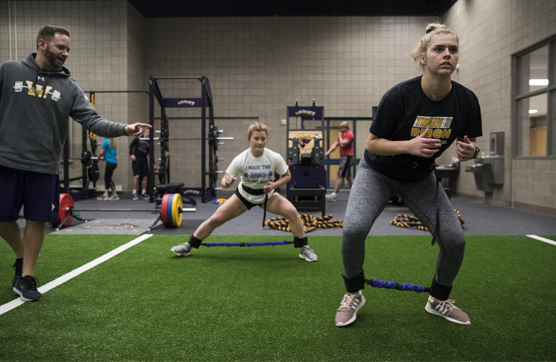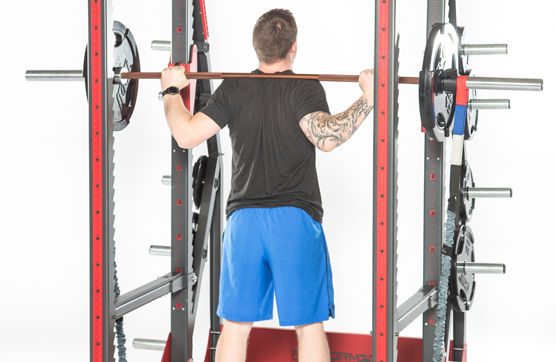The Anatomy of a Perform-X Training Session

The Anatomy of a Perform-X Training Session
By Dan Hutchison, MS, ATC, CSCS
How do you design and “flow” your training session? Do you write out the workout on the whiteboard or hand out a workout card and let the athletes have free reign of the weight room for an hour? Or is there an organized flow to the training session and the room?
In a previous blog, we discussed the importance of matching program philosophy, facility, and flow. The focus of the current blog is to expand upon the concept of ‘flow’ and articulate the execution of a training session using the Perform-X™ Sports Training System (PST) with specific resources that target the key areas of athletic development.
The ‘anatomy’ of the PST session structures the resources & equipment of a performance center, so that each component of athlete development – strength, speed, power, agility, balance, coordination, and conditioning – can be addressed efficiently and effectively. Much like the anatomy of the body, the PST model is a structure of the internal workings of the performance center broken down into areas or zones. Numerous training options are available to develop the areas of strength, speed, power, and agility, but now within an organized and efficient structure involved to assist the coach and/or instructor with the flow of the room and the ability to better manage the room.

ZONES OF PERFORMANCE
Strength Zone: The strength zone consists of weight lifting stations consisting of racks, platforms, benches, barbells, dumbbells or any other resistance training modalities including resistance cords.

Plyometric Zone: The plyometric zone aims to link strength and speed (strength x speed = power) and is defined by inlaid platforms designed with multi-directional plyometric patterns and Trak-X™ anchoring devices to perform horizontal quickness and vertical explosive power movements. This zone may also include the Jump-X™ Machine for bi-lateral and uni-lateral lower body strength and power development.

Speed Zone: The speed zone may include a specifically designed high speed treadmill (Tred-X™ 30/30) to teach sprint mechanics through cognitive feedback and coaching cues, and train running speed through specific programming that includes inclined and/or over-speed runs.

In addition, the four-way multi- hip machine (Hip-X™ Machine) is also a desirable tool in this zone given the importance of hip strength and mobility to sprinting ability and injury prevention. In lieu of the Hip-X machine, four-way hip and hamstring exercise can be accomplished with the Hip-X 360 system.

Functional Zone: This open space or turf area is designed to handle multiple athletes/individuals performing functional tasks to develop general athleticism or sport-specific movements, including cord-loaded applications.

The Performance Zones allow the coach or instructor to formulate a plan based on what aspects of human performance they want to emphasize (i.e., speed, lower body strength, hip mobility, etc.), and where to initiate the session based on the number of individuals in the class or on the team. It is also important to note that a Zone does not necessarily mean only one exercise or task will be performed in that area. A Zone can involve an area or station that can include from 1 to 6 different exercises/drills.

Just as the ‘bones’ of our human anatomy move in a structured sequence to perform specific tasks like walking or bending, the ‘flow’ of the performance center follows a similar pathway. In simplistic terms, we now have a method of taking a large group of individuals, and instead of having the entire group perform one or two exercises or move haphazardly through the space, the group may now be split into 4 distinct groups based on the performance zone.
The following examples illustrate the execution of a PST performance center.
EXAMPLE #1: Larger facility
Team: 40 athletes
Time: 75 minutes (30 minutes per Zone/10 minute Warm-up/5 minute Cool down period)
Groups: 4 groups of 10 athletes
- Group #1 (G1) – Speed Zone
- Group #2 (G2) – Strength Zone (Upper Body emphasis)
- Group #3 (G3) – Plyometric Zone
- Group #4 (G4) – Strength Zone (Lower Body emphasis)
Group Dynamic Warm-up (Functional Zone): The 4 groups of 10 athletes are lined up within the Functional Zone (turf area) to perform a 10 minute dynamic warm-up. The dynamic warm-up is designed to prepare the body for movement, power, and strength-based activity and also enhance joint mobility and stability along with coordination and balance. By adequately raising the internal temperature of the body through progressive drills, allows the athlete to potentially optimize the training experience.
Group #1 (Speed Zone): The 10 athletes assigned to G1 will be split in half. Five athletes will complete the structured speed training protocol using the high-speed treadmill along with the Hip-X; the other five athletes will begin the upper body lifting routine in the Strength Zone. When the first five athletes have completed the speed training station, they will rotate to the Strength Zone for upper body resistance, while the five athletes who were doing the upper body strength will switch to the speed session.

Group #2 (Strength Zone – Upper Body emphasis): The 10 athletes assigned to G2 will begin the upper body resistance training station in one area of the Strength Zone (i.e., 5 squat racks). Athletes will time and count repetitions for each other. Once the 30-minute time frame is completed for this zone, G2 will move on to the Speed Zone. These athletes will complete as much of the upper body resistance routine, until the second half of G1 completes the speed training session. A group of 5 athletes will then transition to the Speed Zone to begin their session. The last group of five athletes in G2 will complete the training session in the Speed Zone, having completed their upper body resistance.

Group #3 (Plyometric Zone): The 10 athletes assigned to G3 will begin the training session using the plyometric platform area following the multi-directional footwork protocol. Athletes will time and count reps for each other. Once the 30 minute time frame is completed, G3 will move to the Strength Zone for lower body resistance.

Group #4 (Strength Zone – Lower Body emphasis): The 10 athletes assigned to G4 will utilize the other portion of the Strength Zone (i.e., 5 squat racks) to perform a lower body resistance routine. Athletes will assist each other in spotting, plate loading, or dumbbell exercises. The coach will prescribe 3-4 exercises for this group. Recovery times between sets will be short, and athletes will always be performing a task, e.g., lifting, spotting, loading/unloading bars, or hydrating. Once the 30-minute time frame is completed, G4 will move on to the Plyometric Zone.

All Groups (Functional Zone): As the groups start to complete their assigned Zones, core training along with an adequate cool down can begin within the Functional Zone. Coaches can delegate captains or other coaches to administer the core routines, and lead specific cool down activities, e.g., static stretching, partner stretching, myofascial release (foam rolling), etc.
*The groups will complete the opposite Zones (G1 and G2 will complete G3 and G4 and visa versa) during the next training session.
EXAMPLE #2: Smaller facility with no high-speed treadmill, Hip-X or Jump-X
Team: 20 athletes
Time: 60 minutes (45 minutes of training time/10 minute Warm-up/5 minute Cool down period)
Groups: 4 groups of 5 athletes (2 Zones complete in training session)
- Group #1 (G1) – Speed Zone (Performed in the Functional Zone)
- Group #2 (G2) – Strength Zone
- Group #3 (G3) – Plyometric Zone
- Group #4 (G4) – Strength Zone
Group Dynamic Warm-up (Functional Zone): The session begins with the 4 groups of 5 athletes lined up within the Functional Zone (turf area) to perform a 10 minute dynamic warm-up.
Group #1 (Speed Zone): The 5 athletes assigned to G1 will perform various speed dynamic drills on the turf space, i.e., the Functional Zone. Drills can be designed to progress from bodyweight to cord-loaded movements to stimulate acceleration and sprint mechanics. The athletes in G1 will move to the Strength Zone once their speed zone drills are completed.

Group #2 (Strength Zone – Upper Body emphasis): The 5 athletes assigned to G2 will begin the resistance training routine. Athletes will time and count repetitions for each other during the time in that zone. The athletes in G2 will switch with G1 once the 20 minutes is completed.
Group #3 (Plyometric Zone): The 5 athletes assigned to G3 will begin the training session using the plyometric platform area following the multi-directional footwork protocol. Athletes will time and count reps for each other. Once the 20-minute time frame is completed, G3 will switch with G4.
Group #4 (Strength Zone – Lower Body emphasis): The 5 athletes assigned to G4 will utilize the other portion of the Strength Zone to perform their resistance routine. Athletes will assist each other in spotting, plate loading, or dumbbell exercises. Once the 20-minute time frame is completed, the G4 group will switch with G3 and move onto the Plyometric Zone.
All Groups (Functional Zone): As the groups start to complete their assigned Zones, core training along with adequate cool down routines, can begin within the Functional Zone area. Coaches can delegate captains or other coaches to administer the core routines, and lead specific cool down activities, e.g., static stretching, partner stretching, myofascial release (foam rolling), etc.
*The groups will complete the opposite Zones during the next training session.
EXAMPLE #3 – Total Performance Session
Team: 20 athletes
Time: 60 minutes (45 minutes of training time/10 minute Warm-up/5 minute Cool down period)
Groups: 3 groups of 6-7 athletes (3 Zones complete in training session)
- Group #1 (G1) – Speed Zone (Performed in the Functional Zone)
- Group #2 (G2) – Strength Zone
- Group #3 (G3) – Plyometric Zone
Group Dynamic Warm-up (Functional Zone): The session begins with the 3 groups of athletes lined up within the Functional Zone (turf area) to perform a 10 minute dynamic warm-up.
Group #1 (Speed Zone): 15 Minutes The athletes assigned to G1 will perform various speed dynamic drills on the turf space, i.e., the Functional Zone. Drills can be designed to progress from bodyweight to cord-loaded movements to stimulate acceleration and sprint mechanics. The athletes in G1 will move to the Strength Zone once their speed zone drills are completed.
Group #2 (Strength Zone – Total Body emphasis): 15 Minutes The athletes assigned to G2 will begin the resistance training routine. Athletes will time and count repetitions for each other during the time in that zone, which will include up to 3 resistance movements. The athletes in G2 will move on to the Plyometric Zone after their 15 minutes is complete
Group #3 (Plyometric Zone): 15 Minutes The athletes assigned to G3 will begin the training session using the plyometric platform area following the multi-directional footwork protocol. Athletes will time and count reps for each other. Once the 15 minute time frame is completed, G3 will go to the Speed Zone.
All Groups (Functional Zone): 5 Minutes The groups will complete an effective circuit involving all areas of athletic performance in a short time-frame. As the groups start to complete their assigned Zones, core training and cool down procedures (see above) will begin.
SUMMARY
Designing and coaching training routines with multiple exercises within multiple Zones takes some time and preparation – and there is no single best way. Some trial-and-error will need to be used based on the age (training/biological), ability level, and sport/PE class, as well as the time allowed for the session and the size and resources within the training space. The performance zone training approach and set-up keeps the training ‘fresh’ and exciting, while stimulating the key areas for developing general athleticism (i.e., speed, strength, power, movement competencies, etc.).